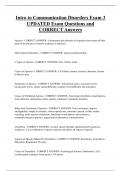Intro to Communication Disorders Exam 3
UPDATED Exam Questions and
CORRECT Answers
Apraxia - CORRECT ANSWER- A neuromuscular disorder of sequenced movement of body
parts in the absence of muscle weakness or paralysis.
Motor Speech Disorders - CORRECT ANSWER- Apraxia and Dysarthria
3 Types of Apraxia - CORRECT ANSWER- Oral, Verbal, Limb
Causes of Apraxia - CORRECT ANSWER- CVA/Stoke, trauma, seizures, dementia, lesions
in Broca's area
Symptoms of Apraxia - CORRECT ANSWER- Articulation errors, consonant errors,
inconsistent errors, cluster sound difficulty, complex word difficulty, flat intonation
Causes of Childhood Apraxia - CORRECT ANSWER- Neurological problems, head injuries,
brain infection, intrauterine stroke, genetic syndromes, metabolic disorders
Behavioral Treatment of Apraxia - CORRECT ANSWER- Voice resonance, improve
intelligability, simple to complex, slower speech rate, automatic speech, visible sounds -
watching, multi-sensory stimulation, functional words phrases and sentences,
systematic/intensive practice, augmentative/alternative communication
Dysarthria - CORRECT ANSWER- A motor speech disorder characterized by paralysis,
weakness, or in coordination of speech muscles and affects all aspects of speech
Aspects of Speech Affected by Dysarthria - CORRECT ANSWER- Resonance, Articulation,
Phonation, Respiration, Prosody
Causes of Dysarthria - CORRECT ANSWER- Neurological diseases, Parkinson's, ALS,
cerebral palsy, traumatic brain injury, CVA/stroke
, Respiratory Problems Associated with Dysarthria - CORRECT ANSWER- Irregular
breathing, forced inhalation and exhalation, running out of air
Phonatory Problems Associated with Dysarthria - CORRECT ANSWER- Voice production
and quality
Resonance Problems Associated with Dysarthria - CORRECT ANSWER- Hypernasality,
Hyponasality
Articulatory Problems Associated with Dysarthria - CORRECT ANSWER- Speech
production
Prosodic Problems Associated with Dysarthria - CORRECT ANSWER- Inappropriate rate
and rhythm
AtaxicDysarthria - CORRECT ANSWER- Damage to cerebellum, balance problems, slow
speech, prosodic problems, inappropriate stress on words, slurred "drunken" speech, mono
pitch
Flaccid Dysarthria - CORRECT ANSWER- Damage to facial and hypoglossal nerves, flabby
muscles, impaired articulation, breathiness, reduced pitch and loudness
Spastic Dysarthria - CORRECT ANSWER- lesions in pyramidal and extrapyramidal systems,
stiff, rigid muscles, weak facial muscles, cause by stroke, TBI, neurological disease
Mixed Dysarthria - CORRECT ANSWER- More than one type of dysarthria, the most
devastating type
Behavioral Dysarthria Treatment - CORRECT ANSWER- Demonstration, modeling, self-
evaluation, self correction of errors
Respiration Dysarthria Treatment - CORRECT ANSWER- Postural adjustment, intake
increase, pacing exercises




